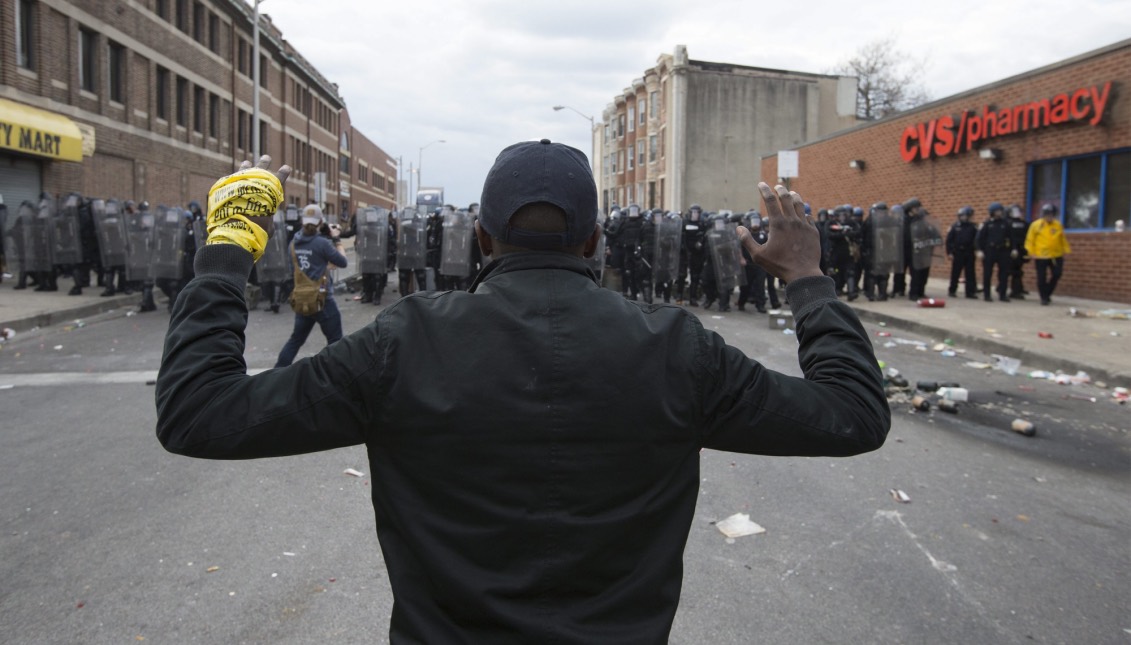
Baltimore and us
We desperately need to talk about militarized police, systemic racism and our national collusion in generational poverty.
Watching the events of the last few days in Baltimore has been painful.
In our newsroom, we followed CNN’s coverage of the riot, which centered visually on the destructive actions of a crowd of young people destroying police cars and storefronts, and aurally on the accounts by police officers of those same young people pelting them with stones, and of fears deemed credible of a “purge” of police officers planned by rival gangs temporarily allied to this end.
We also followed what was happening on Twitter, where the reports of journalists from the Baltimore Sun, along with citizen journalists on the streets, painted a very different picture: School children stranded after school by the police shutdown of all public transit and these same children, hemmed in on all sides by SWAT teams, police in riot gear, smoke bombs and, eventually, rubber bullets.
The event that sparked both the police fears and the protest-turned-riot was the funeral of Freddie Gray, whose spine is alleged to have been severed while he was in police custody, an injury that led to his death.
But no single event led to the chaotic upheaval in Baltimore this week. Rather, a history of events; a series of choices to pour money into militarization of law enforcement to be deployed against our own neighborhoods, and our national collusion in perpetuating both structural racism and generational poverty.
Racism and policing
For years African Americans and Latinos have spoken about “stop-and-frisk” and other policing methods based on racial profiling and on assumptions of criminality.
While the general population may have only recently had their eyes opened about cases in which Black men and children are singled out as threats solely based on skin color (Tamir Rice, Darrien Hunt and John Crawford, for example), it has long been a fundamental reality for African Americans in our nation.
Likewise with the sudden media attention to questionable police actions in apprehending and taking into custody Black men, like Gray.
We cannot look at what happened in Baltimore without looking at the many ways people and neighborhoods of color have been targeted by law enforcement agencies purporting to safeguard the common good. And that even in those instances when police brutality is caught on camera, police officers are likely be exonerated for their excesses if the subject is Black.
We cannot look at what happened in Baltimore without seeing a horrific parallel between the police, who responded with force to what they believed was a credible threat against them, and the people of the West Baltimore neighborhood, who also responded with force to what they believed was a credible threat posed by the police.
Philadelphia parallels
As Helen Ubiñas wrote in her column about Baltimore in the Philadelphia Daily News, it would be ridiculous to look at Baltimore and not see the parallels with Philadelphia.
Relations between police and community are difficult in our City of Brotherly Love, as the wrongful death lawsuit recently filed by the family of Brandon Tate-Brown, questioning the Philadelphia Police Department’s use of force, clearly indicates.
Patrick Kerkstra of Philadelphia Magazine also writes about the Philadelphia police tradition of “nickel rides” akin to the “rough ride” that is presumed to have severed Gray’s spine while in custody of Baltimore police.
Our collusion in poverty
The West Baltimore neighborhood where the rioting took place is a stark reminder of how income inequality in America is often tied to race. In North Baltimore, a mostly white area, the median household income in 2011 was $92,625; in West Baltimore, the median household income that same year was $24,753. In the northern neighborhood only 10 percent of the residents have incomes that fall beneath the poverty level; in the western neighborhood, 34.5 percent do.
For our national collusion in this we need only look at the federal budgets the House and Senate put forth in March: 69 percent of the proposed cuts in funding are in programs that serve low- and moderate-income families. Everything from CHIP to Pell Grants, from food assistance to tax credits that help low- and moderate-income students afford college, are on the chopping block. What isn’t on the chopping block? Tax deductions, exclusions and credits that benefit high-income households.
What next?
We’ve seen a lot of focus on the physical costs of the rioting in Baltimore, less about the human cost of what brought the situation to head there. The Rev. Martin Luther King , Jr. said, “I am aware that there are many who wince at a distinction between property and persons — who hold both sacrosanct. My views are not so rigid. A life is sacred. Property is intended to serve life, and no matter how much we surround it with rights and respect, it has no personal being. It is part of the earth man walks on; it is not man.”
This is a conversation we must have nationally, with both the CNN version of reality and the Twitter one at the table talking. We must have it knowing full well that any conversation that deals with structural racism and income inequality will be deeply painful and uncomfortable. And we must have it anyway.









LEAVE A COMMENT:
Join the discussion! Leave a comment.